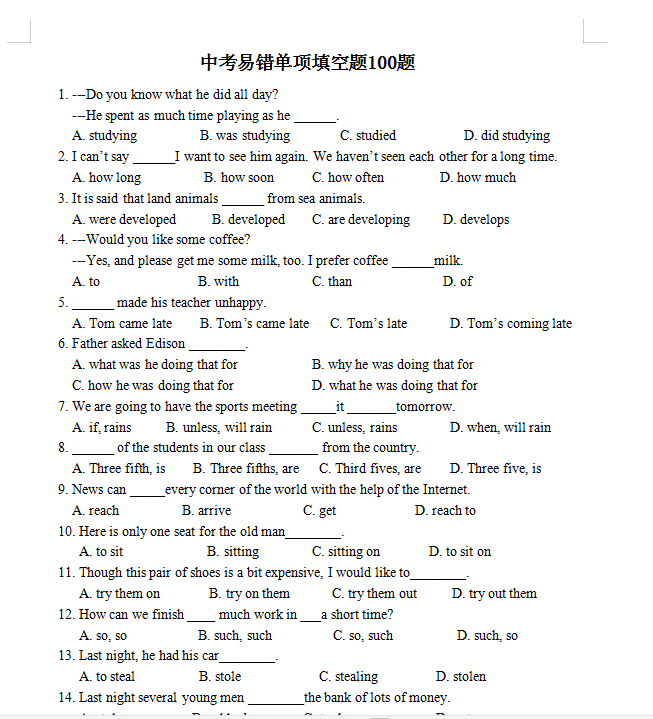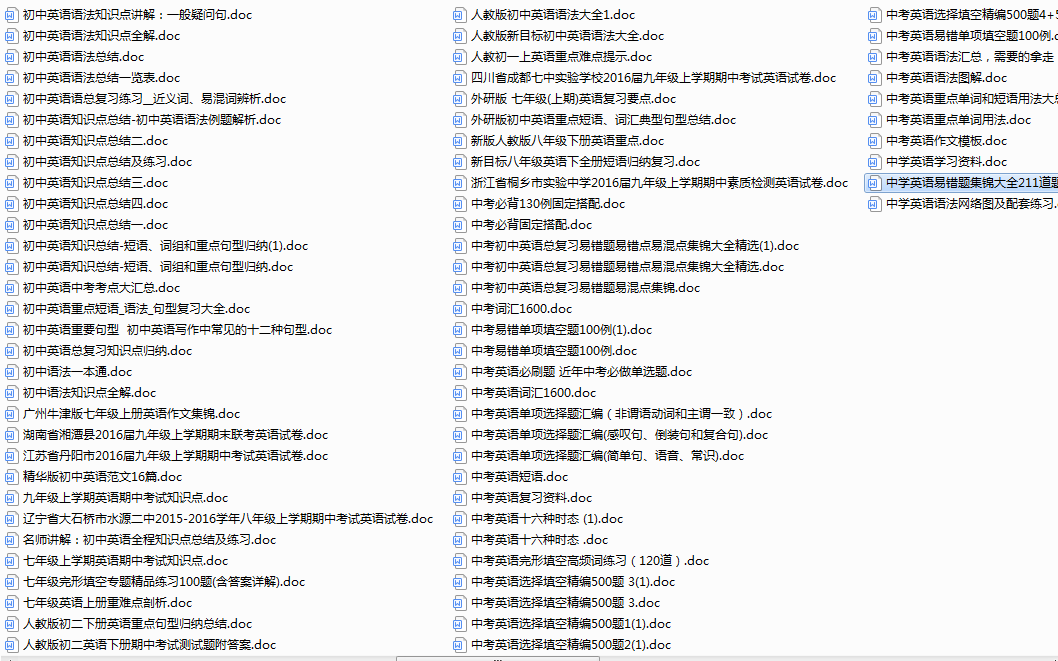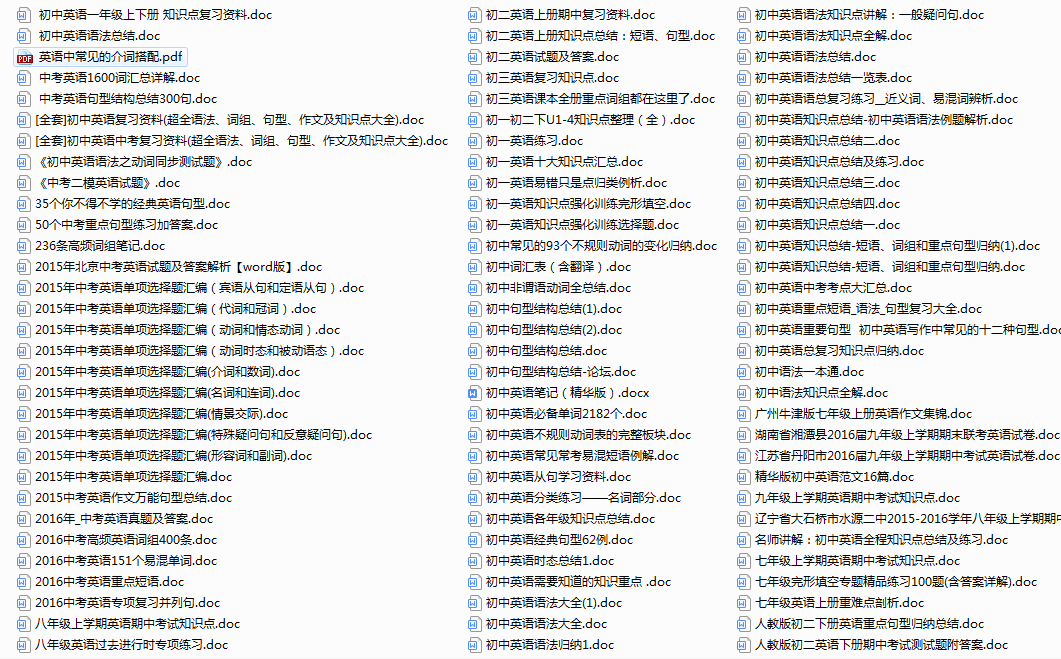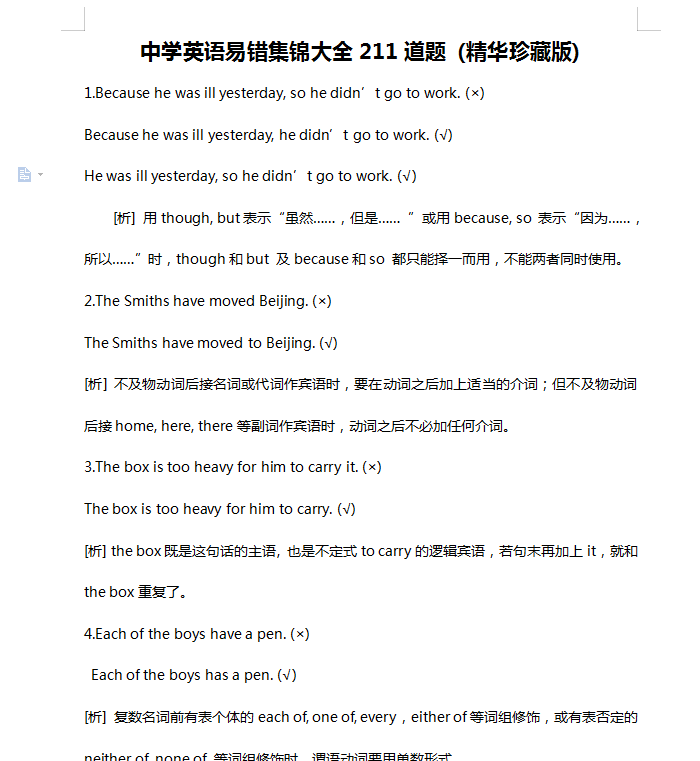编辑点评:初中英语中考必备的知识点合集
2021年中考英语的提分神器,中考英语高频考点和综合模拟复习资料合集免费版,包含了7到9年级英语的所有知识点内容,非常的全面还有一些试题和答案解析,开始复习中考必不可少哟。

初中7-9年级英语知识点汇总图片预览







中学英语易错集锦大全211道题 (精华珍藏版)预览
1.Because he was ill yesterday, so he didn’t go to work. (×)
Because he was ill yesterday, he didn’t go to work. (√)
He was ill yesterday, so he didn’t go to work. (√)
[析] 用though, but表示“虽然……,但是…… ”或用because, so 表示“因为……,所以……”时,though和but 及because和so 都只能择一而用,不能两者同时使用。
2.The Smiths have moved Beijing. (×)
The Smiths have moved to Beijing. (√)
[析] 不及物动词后接名词或代词作宾语时,要在动词之后加上适当的介词;但不及物动词后接home, here, there等副词作宾语时,动词之后不必加任何介词。
3.The box is too heavy for him to carry it. (×)
The box is too heavy for him to carry. (√)
[析] the box既是这句话的主语, 也是不定式to carry的逻辑宾语,若句末再加上it,就和the box重复了。
4.Each of the boys have a pen. (×)
Each of the boys has a pen. (√)
[析] 复数名词前有表个体的each of, one of, every,either of等词组修饰,或有表否定的neither of, none of 等词组修饰时,谓语动词要用单数形式。
5.例:那是你心软!我不就是一个例子吗?
Neither he nor you is good at English. (×)
Neither he nor you are good at English. (√)
[析] either... or..., neither... nor..., not only..., but also... 等词组连接句子的两个主语时,谓语动词遵循“就近一致原则”, 即由靠近谓语的那个主语决定谓语的人称和数用何种形式。
6.Ten minus three are seven. (×)
Ten minus three is seven. (√)
[析] 用英语表示加(plus)、减(minus)等数学运算时,谓语动词也用单数形式。
7.The number of the workers in this factory are about 5,000. (×)
The number of the workers in this factory is about 5,000. (√)
[析] the number of表示“……的数量”,谓语动词用单数形式;a number of 的意思是“若干”或“许多”,相当于some或a lot of,和复数名词连用,谓语动词用复数形式。
8. 例. Hello! I have important something to tell you. (×)
Hello! I have something important to tell you. (√)
[析] 形容词或动词不定式修饰不定代词作定语时,修饰成分要置于不定代词之后。
9. His son is enough old to go to school. (×)
His son is old enough to go to school. (√)
[析] enough作形容词修饰名词时,可以放在名词前,也可放在名词后;作副词修饰形容词或副词时,只能放在形容词或副词之后。
10.. Here is your sweater, put away it.(×)
Here is your sweater, put it away. (√)
[析] put away, pick up, put on等“动词+副词”构成的词组后接代词作宾语时,代词只能放在动词和副词之间。
11. Look! Here the bus comes.(×)
Look! Here comes the bus.(√)
[析] 在以here, there引起的陈述句中,若句子的主语是名词,要用倒装语序,即用“Here /There+动词+名词”结构;但主语若是代词时,则不用倒装语序, 即用“Here/There +代词+动词”结构。
12. I do well in playing football, _______. (我妹妹也行。)A. so my sister does(×)B. so does my sister(√)
Li Lei is really a football fan. --- _______. (确实这样.) A. So is he(×) B. So he is(√)
[析] “so+be动词/助动词+主语”的倒装结构表示前面所述情况也适用于后者,意为“……也是这样”;“so+主语+be动词/助动词”的陈述结构表示对前述情况的肯定,意为“……确实如此”。
13.重庆比中国的其他城市都大。
Chongqing is larger than any city in China. (×)Chongqing is larger than any other city in China. (√)
[析] “any city in China”包括了重庆这座城市, 同一事物自己与自己不能做比较,只有在city 前加上other才能表示重庆和中国的其它城市比较大小。
The weather in Guangzhou is warmer than Beijing. (×)
The weather in Guangzhou is warmer than that in Beijing . (√)
[析] 表示比较时,句子中的两个比较对象必须一致,不同的比较对象不能做比较。错误句的比较对象分别为the weather in Guangzhou和Beijing,这两个不同类的事物之间不能做比较。
14, His sister married with a teacher last summer.(×)His sister married a teacher last summer. (√)
[析] 表达“A和B结婚”,要用A married/will marry B。这时务必要避免受汉语影响使用A married/will marry with B。
15. 例There is going to have a film tonight. (×) There is going to be a film tonight. (√)
[析] 一般将来时用在 There be 句式中时,be going to或will之后的动词原形只能用be,也就是说要用There is (are) going to be.... / There will be....。
16. 例I’ll go hiking if it won’t rain next Sunday. (×)I’ll go hiking if it doesn’t rain next Sunday.(√)
[析] 习惯上在含有时间状语从句和条件状语从句的复合句中,如果主句的谓语动词用了一般将来时,从句的谓语动词要用一般现在时表示将来的动作。
17.例 Teacher told us yesterday that the earth went around the sun. (×)
Teacher told us yesterday that the earth goes around the sun. (√)
[析] 习惯上在含有宾语从句的复合句中,主句的谓语动词用了一般过去时,从句的谓语动词要用过去的某种时态。但如果从句表述的是一客观事实或客观真理时,则不受主句时态的影响,而用一般现在时。
18. All the balls are not round. 翻译成汉语:
所有的球都不是圆的。(×)并不是所有的球都是圆的。(√)
[析] all, every, both等词和not连用时,not通常放在all, every, both的后面,一般情况下表示部分否定,意为“并非……都……”。
19. 例--- He didn’t go to school yesterday, did he?-- _______, though he didn’t feel very well.
A. No, he didn’t (×) B. Yes, he did (√)
例--- Don’t you usually come to school by bike?-- _______. But I sometimes walk.
A. No, I don’t (×) B. Yes, I do (√)
[析] 习惯上英语中的yes意为“是的”,no意为“不”,但在“前否后肯”的反意疑问句或否定疑问句中,yes意为“不”,no意为“是的”。
20.---- Excuse me, is the supermarket far from here?---- No,it's about _______.
A. 7 minutes walk B. 7 minute walk C. 7 minutes' walk D. 7 minute's walk
答案为C。本题考查名词所有格用法。当名词的复数以-s结尾时,则只需要加“'”即可,则“7分钟的距离”为“7 minutes' walk”。
21. You can not imagine how much I ______ on this dress. Is it beautiful?
A. paid B. took C. cost D. spent
[剖析] 答案为D。本题考察四个表“花费”的动词辨析。主语为人,且和介词on搭配的动词是spend。
22. ---- Do you know _____ university student who is talking with Joe?---- Yes, she,s my cousin, Kate.
A. a B. an C. the D. /
[剖析] 答案为C。university虽然以元音字母u开头,但其前若使用不定冠词时,则要用a.不过此题中不能使用不定冠词,而是特指和Joe说话的那个大学生,故要选the。
23. The number of giant pandas is getting ______ because their living areas are becoming farmlands.
A. less and less B. larger and larger C. smaller and smaller D. fewer and
fewer
[剖析] 答案为C。句意为“大熊猫的数量越来越少因为他们的生存空间正逐渐变成农场”。本题中四个选项都是“比较级+ and + 比较级”的结构,表示“越来越……”。主语为number,只能和large或small搭配。而结合句意可判断答案为C。
24. Be careful when you come _______ the street,because the traffic is very busy
at the moment.A. across B. behind C. between D. over
[剖析] 答案为A。本题考察方位介词的用法。“过马路”一般为表面横穿,因此要用across。
25. ---- Do you often clean your classroom?---- Yes, our classroom ______ every day.
A. clean B. cleans C. is cleaned D. Cleaned
[剖析] 答案为C。句中有every day,主语为our classroom,故要用一般现在时的被动语态。
26. Lucy usually cleans the cage every two days. (对画线部分提问)_ _______ Lucy usually clean the cage?
[剖析] 答案为How often does。对every two days提问要用how often。
27. I didn't understand __________,so I raised my hand to ask...
A. what my teacher says B. what does my teacher say C. what my teacher said D. what did my teacher say
[剖析] 答案为C。本题为宾语从句,由于需要用陈述语序可排除B、D;另外,主句时态为一般过去时,则从句也要用对应的过去时态,故还可排除A。
28. ---- How much ______ the shoes? ---- Five dollars ______ enough.
A. is;is B. are;is C. are;are D. is;are
[剖析] 答案为B。shoes作主语时,谓语动词应用复数形式;five dollars是一个整体,应按单数对待。
29. 误〕 We got to the top of the mountain in daybreak. 〔正〕 We got to the top of the mountain at day break.
〔析〕at用于具体时刻之前,如:sunrise, midday, noon, sunset, midnight, night。
30. 〔误〕 Dont sleep at daytime 〔正〕 Dont sleep in daytime.
〔析〕in 要用于较长的一段时间之内,如:in the morning / afternoon, 或 in the week / month / year. 或 in spring / supper /autumn / winter等等。
31. 〔误〕 He became a writter at his twenties 〔正〕 He became a writter in his twenties
〔析〕这句话应译为:他在20多岁时就成了作家。在某人的一段生活时间段中要用介词in来表示,而在具体岁数时用at来表示。
32. 误〕 We went to swim in the river in a very hot day. 〔正〕 We went to swim in the river on a very hot day.
〔析〕具体某一天要用介词on, 又如:on New Years Day
33. 〔误〕 Im looking forward to seeing you on Christmas. 〔正〕 Im looking for ward to seeing you at Christmas.
〔析〕在节日的当天用on,而全部节日期间用at,Christmas是圣诞节期间,一般要有两周或更长的时间。
34. 误 I havent see you during the summer holidays. 正 I havent seen you since the beginning of the summer holidays. 〔析〕 during表示在某一段时间之内,所以一般不与完成时搭配,如:I visited a lot of museums during the holiday. 而for表示一段时间,可以用于完成时,如:I havent see you for a long time. 而through 用来表示时间时则为"整整,全部的时间"。如:It rained through the night.而since则是表达主句动作的起始时间,一般要与完成时连用。
35. 〔误〕 At entering the classroom, I heard the good news. 〔正〕 On entering the classroom, I heard the good news. 〔析〕 On 加动名词表示"一……就"。本句的译文应是:我一进入教室就听见这个好消息了。又如:on hearing… 一听见, on arrival 一到达就……(on表示动作的名词)
36. 〔误〕 In the beginning of the book, there are some interesting stories. 〔正〕 At the beginning of the book, there are some interesting stories. 〔析〕 at the begining与at the end都是指某事物的开始与结束部分,均不指时间范围,而in the beginning 则是指开始一段时间。in the end=at last是指"最终,终于"之意。
37. 〔误〕 Till the end of next week. I will have finished this work. 〔正〕 By the end of next week. I will have finished this work. 〔析〕 by 引起的时间状语表示了动作的截止点,其意思为"不迟于某一时刻将工作做完",所以主句一般是完成时态。当然可以有将来时态,如:Ill be there by five oclock.而till则表达其一动作一直持续到某一时刻,但句中的动词一定要用持续性动词,而瞬间的截止性动词应用其否定句式,如:I wont finish this work till(until) next weekend.
38. 〔误〕 He came to London before last weekend. 〔正〕 He had come to London before last weekend.
〔正〕He came to London two weeks ago. 〔析〕 before 一般要与完成时连用,而ago则与一般过去时连用。
中考英语重点知识归纳
【知识框架】
因为初中英语知识点很多很零碎,所以最好分块整理记忆。一般来说,分为词汇、语法、句型3部分。其中,词汇包括单词和单词变形、词组。
在这里推荐一本中考复习资料,巨微英语《中考英语四轮复习》,全面涵盖中考3114个可考知识点,分词汇、语法、难句、题型4部分,4轮循序渐进,每轮都区分了必考点、基础点和超纲点,备考重点更精准,尤其适合英语基础弱的初三同学。
【中考英语重点知识归纳——词汇篇】
拿你手头的词汇书,或者每册课本后面的单词表,盖住汉语想单词意思,盖住英语想单词拼写。把英汉互译都很顺利的单词划掉,剩下的那些就是你现阶段要解决的单词。
这里分享一下记单词不忘的小技巧。单词总忘,是因为你没复习,你只背过一次单词,之后就再也没看过,如果是这样,当你背到第5页单词时,第1页就全忘光了,这就叫无用功。
艾宾浩斯遗忘曲线提醒我们,刚背完单词,遗忘速度最快,所以刚开始复习勤一点儿,后面就算不复习也不容易忘。比如你早上背了单词,那么中午、晚上、第二天早上各复习一次,周末再来一次总复习,用这样的方法记单词,就会记得很牢。
【中考英语重点知识归纳——语法篇】
初中语法的重难点在于时态和复合句(宾语从句、定语从句、状语从句)。学习语法不能只看概念,一定得自己做题。
上面推荐的那本巨微英语《中考英语四轮复习》就配了一个《随堂1000题》的册子,每学完一个专题,就要立即做题检查自己是否真的掌握了。它还有一本单独成册的答案《1000题精解》,讲答案的同时会帮你回顾知识点。
【中考英语重点知识归纳——句型篇】
句型是语法的升级版,背句型主要是为了作文,为了写出精彩的开头结尾。句型可以分类背,比如计划打算、活动介绍、安全健康、亲子关系等。针对开头句,分别举个例子。
1、sb. have/has made a plan for…某人为……制定了计划。
2、In order to…,sb. am/is/are planning to have a party in…
为了……,某人计划在……举行一个聚会。
3、As far as we know/As we all know, it is very important to keep healthy/safe.
众所周知,保持健康/安全是非常重要的。
4、I have a warm and happy family, and there are 4 people in my family.
我有一个温馨快乐的家,家里有四口人。


 黄冈历年中考物理试卷及答案解析2007-2020年整合版
黄冈历年中考物理试卷及答案解析2007-2020年整合版 黄冈市中考化学试卷2012-2020年整合版
黄冈市中考化学试卷2012-2020年整合版 黄冈中考英语试卷及答案2007-2020整合word版
黄冈中考英语试卷及答案2007-2020整合word版 黄冈数学中考试卷及答案2011-2020年整合版
黄冈数学中考试卷及答案2011-2020年整合版 计算机毕业设计:ASP语言设计完整版
计算机毕业设计:ASP语言设计完整版 专插本英语词汇必备3400pdf
专插本英语词汇必备3400pdf 化妆品行业2021年投资策略报告pdf免费版
化妆品行业2021年投资策略报告pdf免费版 2020全国中考英语真题试卷及答案解析整合版
2020全国中考英语真题试卷及答案解析整合版 2020全国中考数学真题试卷及答案解析汇总大全
2020全国中考数学真题试卷及答案解析汇总大全 2020全国中考语文真题及解析汇总整合版免费版
2020全国中考语文真题及解析汇总整合版免费版



















 2021年四川等地中考真题卷及答案pdf版高清完整版
2021年四川等地中考真题卷及答案pdf版高清完整版 2022河南高三二模试卷及答案解析整合无水印版
2022河南高三二模试卷及答案解析整合无水印版 2022河南高三一模试卷及答案解析免费整合版
2022河南高三一模试卷及答案解析免费整合版 2022中考化学必考知识点总结免费文档word完整版
2022中考化学必考知识点总结免费文档word完整版 MBA英语口语面试真题汇总附面试真题答案
MBA英语口语面试真题汇总附面试真题答案 部编版语文五年级上册单元基础知识复习检测含答案doc 完整版
部编版语文五年级上册单元基础知识复习检测含答案doc 完整版 学校家长沙龙活动方案共三篇doc完整免费版
学校家长沙龙活动方案共三篇doc完整免费版 2020年全国青少年禁毒知识竞赛小学组/中学组题库1.0Word完整免费版
2020年全国青少年禁毒知识竞赛小学组/中学组题库1.0Word完整免费版 重庆市中小学生家庭教育与网络安全观后感docx免费下载
重庆市中小学生家庭教育与网络安全观后感docx免费下载





 新高考复习资料合集
新高考复习资料合集 三年级复习资料合集
三年级复习资料合集 二级建造师考试资料大全
二级建造师考试资料大全 数学题库文档
数学题库文档
热门评论
最新评论